Where to go in Switzerland on a short trip: Alps, lakes, and cities
Switzerland is an extremely popular country for those planning multi-stop tours around Europe, yet very few potential first-time visitors actually know specifically where they want to go. Everyone seems to know that it has the most beautiful views of the Alps and some very impressive cities, but there are actually many misconceptions among casual trip planners, so I’d like to clear most of that up below. The places to visit in Switzerland are not obvious until you’ve been there yourself or done many hours of research, so the list below should be a short cut.
I get hundreds if not thousands of itinerary questions for people who are considering a Eurail trip around Europe, and most people just include the word “Switzerland” among a list of cities like Paris, Rome, and Berlin that they want to visit. So where in Switzerland should you go if you can only make a few stops at most? I’ll answer that question below. You’ll mostly want to focus on the best choices for Swiss Alps trips, which I’ll go over below.
Note: This article was expanded and updated in February, 2024.
Switzerland is about outdoor views rather than city visits
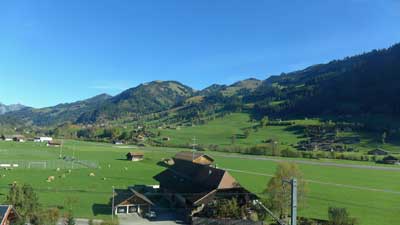
Geneva is a very famous city (though not for tourism reasons) on a lovely lake of the same name, but it’s also notoriously dull and lacking distinction. Rick Steves puts it well by saying that “Geneva is pleasantly situated on a lake, like Buffalo or Cleveland.” The point is, you don’t want to go to Geneva unless you’ve got something specific in mind that you want to see there. There are much better places to visit in Switzerland if your time is limited, or even if it’s not.
Switzerland's cities in summary
Zurich – The largest city, very expensive, geared towards business travelers. It’s generally a pretty and very well-run city that you would enjoy if you visited, but it’s not nearly as interesting as the likes of Vienna, Munich, or of course Paris.
Geneva – Second largest city, in the French part of the country, no major sights. Again, if you visited you’d be very impressed by it and get some great photos, but it’s not worth your time unless you know someone there. There’s an impressive fountain in the lake and you can usually see it from the train as you go through the city, but it’s not really worth going there and staying more than an hour or so.
Basel – Bordering France and Germany, no major sights. It has the famous art market each year, and aside from that it’s even duller than the ones above. Again, if you visited you’d be impressed, but if you later compared photos with friends who went to the Lauterbrunnen Valley instead, you’d kick yourself for going to Basel.
Lausanne – Near Geneva in the French part of the country, very hilly, and certainly more interesting than Geneva.
Bern – The capital, compact, on a lovely river, some interesting sights and the best Swiss city to get a feel for the culture. Bern is fairly close to Interlaken (which we will discuss below) and it can be a great day trip from there, especially on a day where it is foggy and/or rainy in the mountains (and this happens a LOT).
How much time and which Swiss cities to visit?
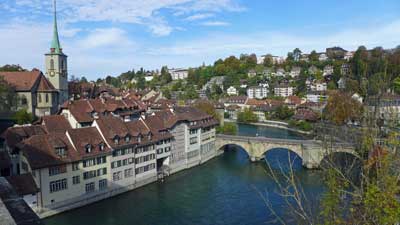
Many people (me included) don’t feel as if they’ve scratched the surface of a new country if they haven’t spent at least a day or two in the largest city. Zurich is certainly pleasant and a useful transit hub so spending one or two nights there wouldn’t be a major mistake. But Zurich isn’t even close to being a city like Paris, Rome, Berlin, Amsterdam, or even Vienna. If you skip it in favor of spending more time in the Swiss Alps, you won’t be missing much.
The 2 Best places to visit in Switzerland for short visits
Interlaken – If you want the best possible Alpine views and activities, head to the Interlaken area, which will be described in detail below. This is my favorite of all places to visit in Switzerland and it will probably be yours as well.
Lucerne – The traditional Swiss tourist retreat, Lucerne is a small city with interesting culture and sights, that is gorgeously set on a lake with plenty of top activities surrounding it.
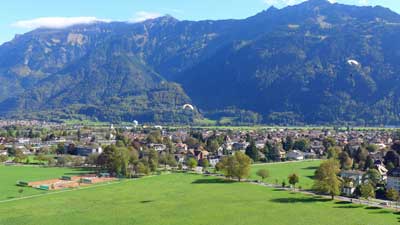
>>>Interlaken and Lucerne: Which to choose and how long to stay in each?
The article linked above will give you more details on which to choose and how long to spend in each place.
What about Zermatt for Alpine views?
Zermatt is a remote car-free village in southern Switzerland that is famous for being the place to see the Matterhorn mountain. It’s also a busy ski resort area, and aside from that, there isn’t much to see or do here. It’s on a private rail line, so it’s more complicated and usually more expensive to reach than Interlaken.
In other words, unless you’ve irrationally placed “Seeing the Matterhorn in person” on your so-called bucket list, skip Zermatt and head to Interlaken on a shorter visit. You won’t be sorry. If you already have enough time in your visit for the main sights around Interlaken and Lucerne and you want to also see the Matterhorn, then by all means go and you’ll enjoy it. There are quite a few other car-free villages in the Lauterbrunnen Valley near Interlaken, so they are not as novel in Switzerland as one might expect.
A weekend in Switzerland? What to see in 3 days
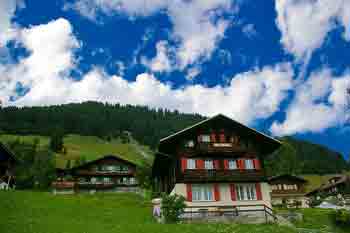
One challenge is that neither has an international airport so you’ll either be flying into Zurich or perhaps Geneva.
Train times from Zurich to Lucerne to Interlaken and back
- Zurich Airport to Lucerne: 1 hour 10 minutes by train
- Lucerne to Interlaken: 2 hours by train
- Interlaken to Zurich Airport: 2 hours 15 minutes by train
As you can see with the travel times above, Zurich Airport to Lucerne is a fairly short trip, but once you add Interlaken into the mix (even if you skip Lucerne) the travel time starts to add up for a weekend visit. With this in mind it’s probably best to just choose one of them and save the other one for another trip.
Lucerne is gorgeous, but the Lauterbrunnen Valley near Interlaken is really the star of the show, so I’d recommend going there first and doing Lucerne on another trip.
What about the Swiss Travel Pass?

The bottom line is that if you are coming to Switzerland for at least 3 days and you want to take 2 or more of the amazing scenic rail journeys that the country is famous for, the travel pass is probably a good deal. It also provides 50% discounts on the Schilthorn cable car and 25% off the Jungfraujoch mountain railway. Both of those are quite expensive on their own, but extremely worthwhile, so the discount is helpful.
The Half Fare Card is probably a better deal for most people
The Swiss Travel Pass is a good deal for those who are going to be spending at least 2 or 3 days riding the rails and seeing Switzerland that way. But if you are mostly going to be focusing on Interlaken and Lucerne and the mountain sights, the Half Fare Card is the best option. For CHF120 (about US$134) you get the card that is good for 30 days and gives you a 50% discount on all trains, cable cars, mountain railways, and other sights and attractions. If you are doing either Schilthorn or Jungfraujoch, the Half Fare Card practically pays for itself with just one of those.
>>>Buy the Swiss Half Fare Card
Many people have questions about the Swiss Half Fare Card so I will explain it a bit here. You can actually buy half price train tickets for travel within Switzerland any time you want and you will see that option when you go to buy them online. The only thing is you have to have and present a valid Half Fare Card when you get on the train and are asked to see your ticket. In other words, you can buy a half fare train ticket today and buy a Half Fare Card just before you get on that train months in the future, and you are fine.
How and why visit the area around Interlaken
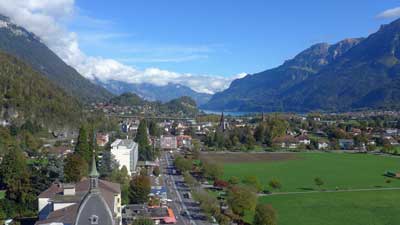
You can see everything discussed below by actually staying in a hotel in Interlaken, but it’s not the Alpine experience that you get if you stay in one of the small villages nearby. You can reach those villages in 20 to 40 minutes from the Interlaken Ost (East) train station, and it’s much easier than it sounds.
The 3 best places to stay to visit the Swiss Alps
Lauterbrunnen – A private train line runs from Interlaken Ost station to the end of its line in Lauterbrunnen. There’s a lovely waterfall here and great hiking trails, but you should probably only stay here if you can’t get to one of the villages mentioned just below. It’s a great little transit hub and it’s definitely gorgeous, so it can be worth a night if you’ve got one to spare.
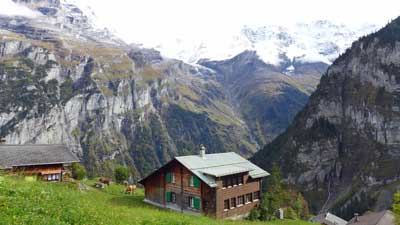
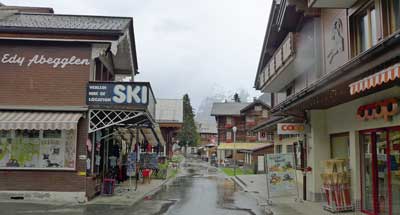
Where to stay in Interlaken and the Lauterbrunnen Valley (with pics)
I get so many questions about where to stay in the Interlaken area that I decided to write a longer version of it and load it with huge photos so readers can get a better feel for each option. I also included recommendations for affordable and well-located photos in each area.
>>>Where to stay in Interlaken and the Lauterbrunnen Valley New for 2024!
The unforgettable things to see here (if the weather is decent)
Schilthorn observation deck and restaurant
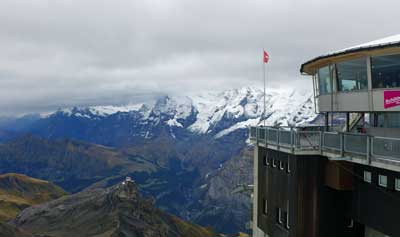
There is a rotating restaurant (with prices similar to normal Swiss restaurants) and a bizarre and anachronistic James Bond attraction based on it being a key location in the 1969 movie On Her Majesty’s Secret Service. The Bond thing is included with the lift, and it’s worth a look.
But the main thing you come here for is the 360-degree view from one of the highest peaks in Europe. Again, the weather here is key, but fortunately all the locals track the visibility on a minute-by-minute basis. If it’s clear up top while you are in the area, it would be a terrible shame to skip it based on the high price. But even if it’s cloudy up top, there are still plenty of wonderful things to see and do in the villages below.
Jungfraujoch observation area
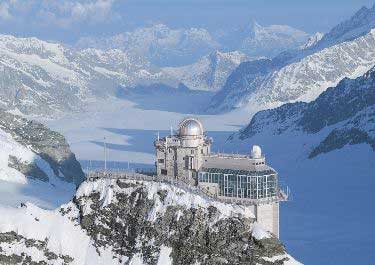
The views from the top are similar to the views from Schilthorn, from the other side of the Lauterbrunnen Valley. Once on top you can have lunch, hike, or even go sledding. It’s also quite expensive at nearly US$200 round-trip unless you have a Swiss Pass or a Eurail Pass for discounts, and it takes most of your day, but you’ll never forget the views from the top.
Harder Kulm mountain and Two Lakes Bridge Observation Deck
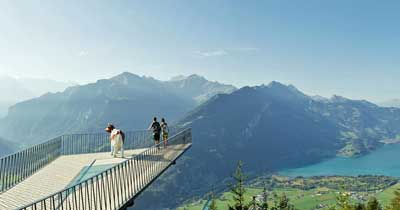
There’s a revolving restaurant about 10 minutes’ walk from the station at the top, which is definitely an unforgettable place for lunch if you’ve got time. It’s not as expensive as you might expect, at least compared to normal restaurants in Switzerland.
The Harder Kulm Railway goes from early April through late November each year. If you are only in Interlaken for one day and/or you are on a strict budget, this is the fastest and best way to get amazing Alpine views in the area.
Getting from Interlaken to Gimmelwald and Mürren
Getting up to these villages sounds complicated and time consuming, but it’s actually fast and easy once you get there. This little guide should help.
Arrive in Interlaken
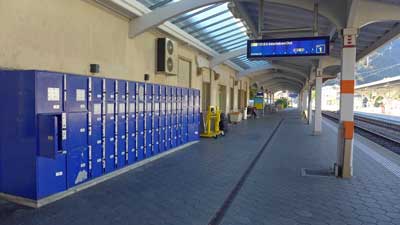
Once you arrive at the Interlaken Ost train station, head for the ticket windows in the office and buy a ticket to your final destination (Lauterbrunnen, Gimmelwald, or Mürren). Eurail passes are good for 25% discounts on the rest of the trip, but not for the whole thing.
From Interlaken Ost to Lauterbrunnen
The private train leaves Interlaken Ost every 30 minutes and arrives in Lauterbrunnen 20 minutes later. If you are staying in Lauterbrunnen then you are probably walking distance from your hotel when you reach the station.
From Lauterbrunnen to Gimmelwald
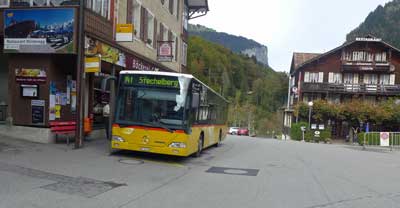

From
Gimmelwald to Mürren
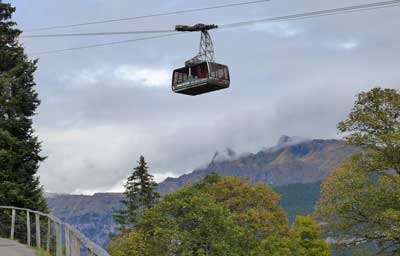
Recommended hotel and hostel in Gimmelwald
I get asked all the time about where to stay in Gimmelwald, so here it is:
Hotel: Esther’s Guesthouse
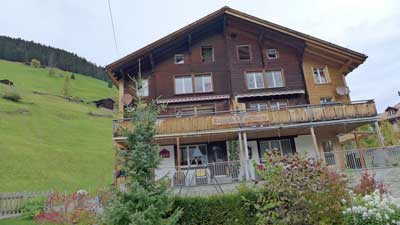
It’s run by Esther, as you might guess, and she is very friendly speaking excellent English. Each room is different and the place feels like a mountain cabin, because it is. She offers an excellent buffet breakfast in the morning, which you have to order the night before. It’s not cheap, but it’s worth it because it’s hearty and there are no other good options nearby.
Book as early as possible because this place is often the first place to sell out in Gimmelwald.
Hostel: Mountain Hostel Gimmelwald
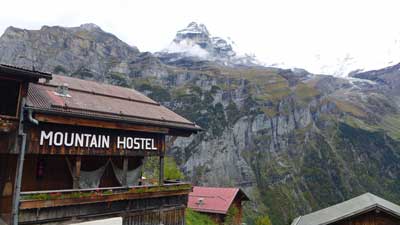
You won’t believe the views from this place, which are the same as from Esther’s except a bit lower and more unobstructed. This place also has a busy bar and restaurant that is basically the only “nightlife” in Gimmelwald. Many hikers get to bed early in this tiny village, but if you want to have a couple drinks and order a pizza or some local options, this is the place to go.
Again, book early because this place is always sold out.
Lucerne and what to do there
Luzern, as it’s spelled locally, is the other traditional holiday destination in Switzerland. Unlike Interlaken, Lucerne actually qualifies as a small city rather than a small resort town, so it’s a very nice contrast and very worthwhile. We have a new article with advice on where to stay in Lucerne and it should be helpful.
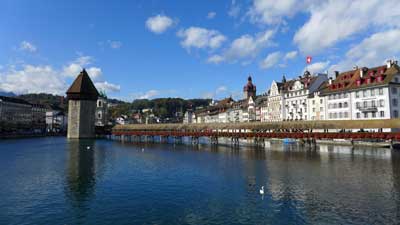
However, unlike Interlaken, the town of Lucerne itself is a great attraction and worth at least a day of exploration. This has always been a rich area so you can expect to find all of the high-end shops and boutiques along the small streets just north of the lake, but there are also many traditional shops and things to see that will appeal to anyone.
Recommended hotel in Lucerne
>>Hotel Des Alpes (3 stars with an amazing location and view)

If this place is booked, which is often the case, then book a hotel as close to it as you can find or afford. The whole historic part of town surrounding it is lovely, with restaurants, bars, and high-end shops. There are also a couple of nearby supermarkets where you can buy inexpensive alcohol and picnic supplies to keep other costs down.
Spend a day in Lucerne itself
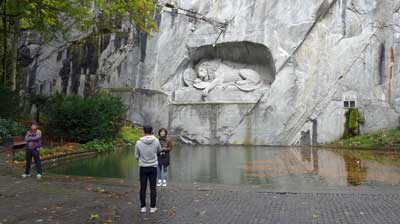
Most of the interesting part of Lucerne is in the area behind those restaurants, and it’s certainly worth doing a self-guided walking tour if not a guided one. Heading farther east you’ll come to another older part of town where the famous lion statue is located. You can’t visit Lucerne without having a look at the lion, and fortunately it’s easy and quick to reach (and it’s free).
Take a lake cruise of some kind
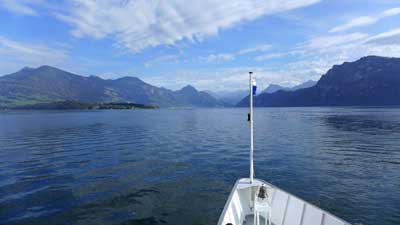
Especially in nice weather, even the short lake tour is lovely, and if you have more time you can jump off at Vitznau and do the scenic hike up Mount Rigi. There are also small lakeside villages that are ideal for a stroll and lunch stop. Long story short, there are dozens of interesting sightseeing options that are available using part of the boat tour, and the views all around are wonderful.
Visit Mount Pilatus
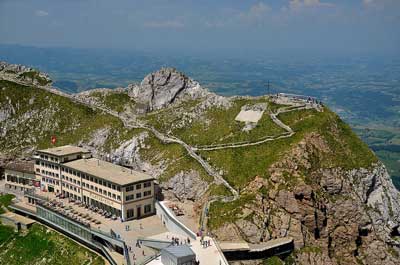
You can take the cogwheel train up and have a more or less flat hike around the summit area, and then take the gondola and cable car back down again. You can do them in the other order, and the cost is the same either way. At around US$65, this is not a cheap hike, but like most everything in Switzerland, the quality is high so it doesn’t feel like a rip-off. You can reach the cable car in 10 minutes on a public trolly bus from Lucerne.
Visit Mount Rigi
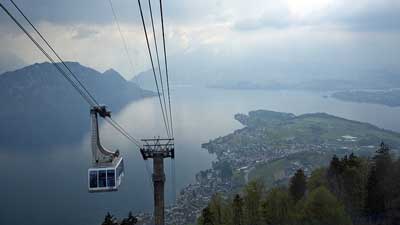
Unlike the other peaks mentioned in this article the Swiss Travel Pass covers both ways to get up and down for free. The others are 50% off with the Swiss Travel Pass or Half Fare Card, except for Jungfraujoch, which is only 25% off with the Swiss Travel Pass and still 50% off with the Half Fare Card.
Visit Mount Titlis
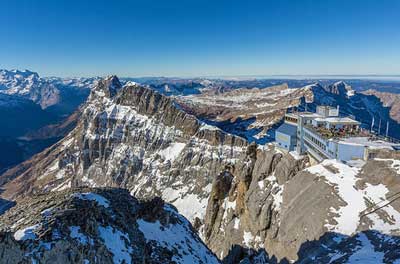
You can reach Titlis by taking a 43-minute train ride from Lucerne to Engelburg and then taking the cable car up from there. As with the others, it’s wise to check the weather immediately before you are going to depart because it can be foggy or cloudy any time of the year, but usually not for whole days at a time.
Additional photo credits
Jungfraujoch by cupweuro on Flickr, Pilatus by Tony Fernandez on Flickr, Rigi by Kosala Bandara on Flickr, Titlis by PaulSchliebs on Flickr

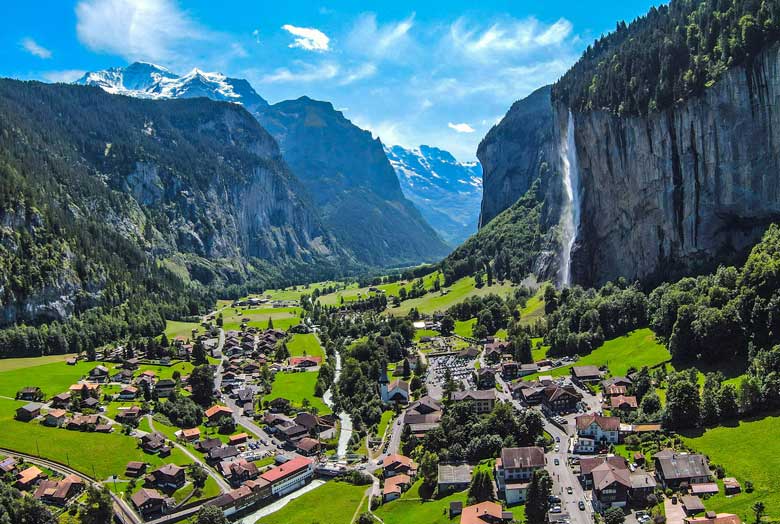
Roger,
My wife and I will be traveling from Rome at the end of this April. We have about 3 days (which includes travel). Choice 1 is Almafi Coast and Choice 2 is Switzerland. If we decide Switzerland – any thoughts on best place to park for 2-3 days that time of year and any thoughts on travel from Rome?
Thanks for your help
Dan,
To reach the Amalfi Coast from Rome you just take a high-speed train to Naples and then walk into the other train station below the main one to board the Circumvesuviana train that reaches Sorrento in about an hour. Sorrento is a lovely town (with quite a bit of English spoken) and there is a bus that leaves hourly from in front of the train station that goes all along the Amalfi Coast and can drop you in any of the towns there. Late April will still be a bit chilly in Amalfi, as it’s mostly a summer holiday area.
If you want to go to Switzerland I would recommend the Interlaken area, as described in the article above. You can take a train from Rome to Milan and then another train from Milan to Interlaken that offers amazing views of the Alps as you pass through. If you somehow prefer to drive you’ll actually find that some of the hotels in Interlaken have free parking and it’s easy to drive to most of the sights and view points. Interlaken is one of the rare tourist cities in Europe that is small enough and spread out enough where parking is possible like that. Personally, if I was coming from Rome and had that choice I would definitely go to Switzerland. The Amalfi Coast is photogenic in many places, but it’s mostly just a few beach towns built on steep hills that are filled with clothing boutiques and such, and it’ll be too cold to enjoy the water in late April. But Interlaken has some of Europe’s most amazing scenery, although it is a bit expensive. Let me know if you have any other questions. -Roger
Roger, Im in the process of scheduling a trip to Gimmelwald/Lauterbrunnen around the end of September. I have been reading your replies to questions and they have been very informative for me to plan a trip. Do you have an email I could use when I get further along in my plans? I am trying to coordinate my trip to include Munich/Octoberfest/Dachau. I have to figure out if it makes more sense coming from the US to fly into Munich first or into Switzerland first. Thanks for your help!
Jack,
I’m glad these comments have helped. I’m happy to answer comments in public for that exact reason that other people can read them and perhaps are helped by them as well. But I don’t really do private consulting in the same way. Dachau is easily reached on a public bus from central Munich. Hotel prices in Munich are about triple the normal rates during Oktoberfest, so book early. You should also arrange a reservation to get into one of the tents, as the lines to get in are often long if you just walk up on the day. Let me know if you have any other questions. -Roger
Hi Roger,
Thanks for the reply, really appreciate it.
I trying to play around with the ticket price to determine which is the better option for me. Am i right to be using http://www.sbb.ch for the price comparision? Also noticed that on sbb.ch i am able to choose the half fare travel card but not the travel pass. Is that the same as the half fare card? or what i should really be doing is to look at the no discount price, and do the 50% (half fare) and 25% (travel pass) calculation myself?
Thanks again.
Shu,
Yes, sbb.ch is the official Swiss Rail site and it’s the best place to research and buy those train tickets. For trains you can select the Half Fare Card, which of course displays half the fare so you can buy those tickets and then show them along with your Half Fare Card once on the train. If you have a Swiss Travel Pass you don’t even need tickets on trains, as you can just hop aboard and show your pass when asked. For things like Jungfraujoch or the special panorama carriages on certain scenic trains, it will show an option to buy with a Swiss Travel Pass. It will show the supplement you need to pay for a seat reservation or any other fee. But again, for normal train rides between cities, the Swiss Travel Pass works in place of tickets, as long as it’s valid on that day. Let me know if you have any other questions. -Roger
Hi Roger,
I am planning to spend about 9 days in Switzerland in Mar’18 and are looking for some advice on place to visit and the type of swiss pass to purchase. appreciate if you could comment on my rough plan and help in deciding the type of swiss pass i should get
Day 1
– Taking a train to Spiez from Venice
– Transfer to Wengen where i will be base for 4 nights
– is this the best way to travel?
Day 2-4
– hit the attractions around the area
– hoping to cover Jungfraujoch, schilthorn and maybe some hike if possible
– any particular place i should be hitting
Day 5
– Travel to lucerne
– explore the town/some boat ride maybe
Day 6-8
– want to do a day trip to Zurich on one of the day
– day trip to either Pilatus or Rigi (any thoughts?)
– any other places worth visiting?
Day 9
Train to Zurich airport for a 11am flight
thanks
Shu,
I’ll answer your questions in the order they came up…
Yes, that train ride from Venice to Spiez is spectacular, so I hope you can do it during daylight hours. It’s also the fastest way to get there. Buy that ticket as early as you can for the best price.
Jungfraujoch and Schilthorn are the big two amazing sights in the Interlaken area, and in the process of visiting them you’ll also come close to several other worthwhile things, so it kind of takes care of itself as long as you read up a bit before you go. As I mention in the article, on your way down from Schilthorn I highly recommend getting off the cable car in Murren and then hiking down to Gimmelwald after looking around Murren for a bit. Gimmelwald is a tiny farming village that you won’t believe still exists in modern times, and the walk is very easy since it’s downhill.
From Lucerne you have Rigi, Titlis, and Pilatus, which are all described in the article above. It mostly depends on the experience you want to have. Rigi is easy to visit while on the boat trip that is also highly recommended.
As for Zurich, I think a day trip could be a good idea, but honestly you wouldn’t be missing much if you skipped it and used that day for more natural sights. Zurich is pleasant enough, but it’s kind of plain compared to cities like Vienna or Paris, and it’s ridiculously expensive (although mostly just for hotels and restaurants, so a day trip wouldn’t be bad). And as I mention in the article, Bern (the capital) is more scenic and more interesting as well, so you might think of a day trip there instead.
Overall your plan looks great and I’m sure it’ll be an excellent trip. Since you aren’t planning many longer train rides I’d say the Half Fare Card would save you the most money, partly since it gives a better discount on Jungfraujoch. But if you might be doing a few more even shorter train trips on those days, the Swiss Travel Pass itself might end up the better bargain. Either of those will be far cheaper than paying as you go. Let me know if you have any other questions. -Roger
Hi Roger,
Thanks for so good advice. My sister & me will be reaching Swiss from Rome on this 29th evening & then be there for next 2 days-30th & 31st of Dec’17(new year time) then we will head towards Paris on 2nd Jan night. From all your past posts, kindly guide us where we should go for this short trip, like Interlaken, Murren, Gimmelwald, Bern, Lucerne, I want to experience Schilthorn, Jungfro(if possible in this tenure), Cable Cars, some skiing. Also, do i need any train pass or should i directly buy tickets there. Also, in terms of hotel which place will be favourable & close to these sites. Also, how will be the weather during Winters & will its advisable to be here during Winters & New Year Time, please guide. Thanks a lot in advance.
Abhishek,
For a short trip like that I would go straight to the Interlaken area. I would probably recommend staying in Interlaken itself, and from there you can easily visit Gimmelwald and Murren on your way up to Schilthorn, and you can also visit Jungfraujoch. If you had another day or two you might also go to Lucerne, but for 2 or 3 days I would just stay around Interlaken, as it has the most dramatic peaks and sights. The article above describes how you get to the cable car that goes up to Gimmelwald, Murren, and Schilthorn.
I just checked and it’s snowing in Murren starting a few days ago, so the lifts are already open. There are also ski lifts in Grindelwald, which is on your way up to Jungfraujoch, and in that same small area. I don’t have a specific hotel in mind for you, but I think the best location is something within a short walk of the Interlaken Ost (east) train station, because that’s the hub that takes you to Lauterbrunnen and then up either mountain on each side. There will be snow up in the mountains (and there is snow at the highest peaks all year round), but there probably won’t be snow on the ground in Interlaken itself, which is another good reason to base yourself there. The Swiss do an excellent job of keeping roads and train tracks open when it snows, but if you get very unlucky you might be there during a storm. It’s beautiful there in winter with the snow, so there is always a slight risk of being there when it’s coming down hard, even in the valleys.
As for train tickets, I think a Half Fare Card for each adult in your group will save you the most money. I describe it in my article about the Swiss Travel Pass. They cost about US$120 each, but then save you 50% on all trains and cable cars and boat rides in Switzerland. Since those things are quite expensive there, especially Jungfraujoch and Schilthorn, the Half Fare Card pays for itself quickly. Let me know if you have any other questions. -Roger
Hello Roger, Many thanks for answering others Queries. It helped me in making my Swiss plans. I am planning my trip in feb second week for few days. I am on a tight budget situation and large potion of my budget is getting spent in travel cost from my home country to Swiss itself. Please review and share your feedback on below plan.
Day1:
Reach Zurich in morning:
Option1:Travel directy to Lucerne:
Checkin at hotel, Roam in city, Sleep in night at Lucerne.
Option2: Keep Luggage in train station lockers and visit Zurich Lake and Rhine Falls,
then Start for Lucerne in Evening, Checkin at Lucerne, take rest in night.
===============
Day 2:
Next day go to mt rigi ,
Return back from Rigi and take your belongings, Start for next base
Checking at hotel at next base in Gimmelwald or Wengen or Lauterbreunnen:
(If time pemits visit Interlaken after checkin, Sleep in night at next base)
Considered point: Rigi will be covered under my Swiss Travel pass, Mt Pilatus and Mt Titlis have been skipped because got to know Jungfrau is similar in nature so they can be skipped
================
Day 3:
next day start for
Jungfrau, Jungrfraujoch, this Will take 6 hours so almost a day gone here
return back to hotel, Sleep in night at the same base.
=================
Day 4:
Next day Go to Murren , Munch , Canton of Bern, Valais and Schilthorn
Return Back to hotel and take your belongings
Option A:
Start for Zermatt, Reach Zermatt , checkin at hotel,sleep
Option B:
Start for Montreux, Reach next base (Either Montreux, Lousanne or Basel) , checkin at hotel,sleep
=================
Day 5:
Option A continued from day 4 plan:
See Mattehorn. Start from Zermatt and Board Glacier Express,
Tavel on Glacier Express, Reach till Chur, Start for Zurich, Stay overnight in Zurich.
next day board flight to Paris.
Option B continued from day 4 plan:
Wake up in (Either Montreux, Lousanne or Basel) , Visit the nearby places. and then start for Paris(Flight/Train).
I am planning to take the Swiss Travel Paas for 4 days , Which comes with a free 5th day use.
We are travelling as a couple and thinking to achieve the max whihc we can in this short trip.
This is my stay/ Duration plan considering some of the mazor tourist attraction. Individual city detailed plan
I am yet to make.
Please advice wether the overall plan seems good. Also would be helpful if you could suggest the better option among those listed.
Thanks in advance.
Shreya,
This is a very impressive plan and I think it will work well. The free day on the Swiss Travel Pass will also be a huge help.
Out of those two options I think I would go with Zermatt and the Matterhorn, although if you really want to visit a Swiss city then Montreux might be good. As I’ve mentioned before, many Swiss cities (not including Basel) have a photogenic location, but the cities themselves just aren’t very charming or interesting. Bern is the most charming and it has a very nice location with a river snaking through it, but those others aren’t very distinctive. The cities also tend to be even more expensive than the smaller tourist towns. On the other hand, after seeing so many of the best Alps views, going to such lengths to see one more of the Matterhorn might not be worth it? I am sure you’d enjoy either choice, so it’s just a matter of what you feel better about. As mentioned, your plan seems very thorough and well timed, so I am sure this will be a wonderful trip. -Roger
Hi Roger,
Thanks a lot for your valuable inputs and useful links. I prefer calm and peaceful stay, so preferred Lauterbrunnen instead Interlaken.
Thanks again!!
Hi Roger,
Before i seek your suggestion, i really appreciate you for your invaluable suggestions for us in this page. Thanks a lot!!
I would be travelling to swiss with my wife and 20 months old infant from 13th of april 2018 for 7 days.after reading all your comments i have made this itinerary.
Travel dates 13th april to 19th with 2 bases. Luzern and lauterbrunnen.
Day 1 arrival at zurich, take train to luzern and check in to hotel by 2. Later exploring luzern in the evening.
Day 2 mt titlis if weather permits.
If not some lake trip..need your tips in this
Day 3. Back up for titlis/ pilatus.
Day 4 to interlaken golden pass route n then to lauterbrunnen rest of the day in leisure at lauterbrunnen ( trummelbach falls n local sight seeing)
Day 5. Mt jungfrau if weather permits if not gimmelwald murren wengen.
Day 6 back up day for jungfrau.
Day 7. Grindelwald first cliff walk ( since my flight is at late night i hope i can take this) later in the afternoon check out n depart to zurich
Kindly advice if this is ok. Any toboggan would be in operation at this part of year. Am pretty much interested in it.
Thanks a lot!! Cheers
Siva,
Your trip looks very well planned out and I think it’s wise to include those backup dates in case the weather doesn’t cooperate. The Lucerne lake trip is a classic. There are many different lake cruises that go each day, but the most popular and common one is a 2-hour loop that leaves from in front of the train station and visits 4 or 5 villages around the perimeter before returning to Lucerne. You can go up Mt. Rigi from one of these stops, and then continue the cruise to the other stops when you come down. It’s a hop-on, hop-off boat, so you can spend all day visiting villages and doing things if you like. There are plenty of other good things to see and do in Lucerne, so you won’t have any problem finding options if you are there and the weather at the peak is cloudy or raining.
As for Lauterbrunnen, it’s the main hub for transportation into the Alps above, but it’s also a tiny village without much to do until you get a bit out of town. It’s deep in a valley with a gorgeous location, though Gimmelwald and Murren are above it and both of those are more memorable places to spend the night. If you don’t mind having a limited choice of restaurants (and a fairly large supermarket as well), then Lauterbrunnen will be lovely. But Interlaken is only 15 minutes away by train and it’s much larger with more options, so that’s another one to consider.
I’ve not done a toboggan or sled in Switzerland, but here is some information on some of the places in or near Interlaken where you can do it. Mid April might be around the end of the season, but if there is one with a higher altitude you might still be able to do it. Best of luck on all of this. -Roger
Hi Roger,
My husband & I are planning to visit Switzerland in Easter 2018 for 5 days 4 nights. Could you please advise how should I plan my trip. Which travel card shall I go for, where should I stay.
I’d like to visit the following (however, the list in lengthy):
Interlaken, lauterbrunnen, gimmelwald, murren, scholhorn, junggraujoch, grindelwald, saanen, gstaad, lucerne, lake geneva, montreux, rhine fall, titlis.
Please advise which place to visit first and after.
Dolly,
Assuming you mean Schilthorn, you can see the first five places on your list in one fast-moving day. And you can see Grindelwald and Jungfraujoch on the next day. After that I would head to Lucerne to see Titlis and you might also have time for the Rhine Falls. Lake Geneva is obviously in the other direction and you’d really have to choose Lucerne or Geneva, and I would definitely do Lucerne if I were you. Lake Geneva is a very nice looking lake with some photogenic cities along it, but Lucerne has far better and more interesting scenery.
I’d say the Half Fare Card would be your best ticket bargain. I discuss it and the other options in this article about the Swiss Travel Pass. Let me know if you have any other questions. -Roger
Hi Roger,
We are a couple with a 13 year son planning a swiss trip in May 2018.
Generally we like to stay 3 to 4 nights at any new place we visit which gives us time to explore the area. We are not skiing enthusiasts but would like to explore natural beauty of mountains and lakes. Thus, planning for 3 to 4 nights each at Interlaken and Lucerne. However, after reading above article I am tempted to change the schedule and also include 3 nights at Murren. Also planning to take the Swiss Travel Pass or Rail Pass. Would appreciate if you can explain the differences between the two. Thanks – K R Cooper
KR,
The good news is the Murren (and Gimmelwald) are small villages on the side of one of the mountains just above Interlaken. The town of Interlaken itself is pleasant, but nearly all of the best sights are in the nearby mountains, including in and above Murren. In fact, the cable car that goes up to Schilthorn stops in Murren on the way up. If you are staying 4 nights in Interlaken, which I think is a great amount, you could stay two nights in Murren or Gimmelwald and the other two nights in Interlaken itself. They are a short distance apart, although it does take about an hour to get from one to the other.
I have a whole article that discusses the Swiss Travel Pass with its pros and cons. The short version is that a Eurail Pass can be good for Switzerland if you are also visiting at least a few other countries. The Swiss Travel Pass is ideal for those who are doing at least two of the longer scenic train rides. For most other people, the Half Fare Card is the best choice, and I discuss it in the article as well. Let me know if you have any other questions. -Roger